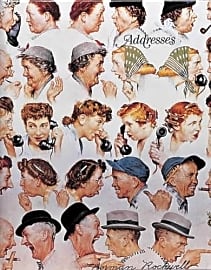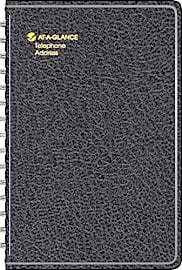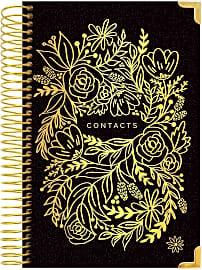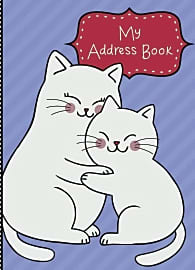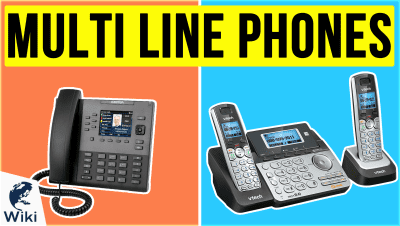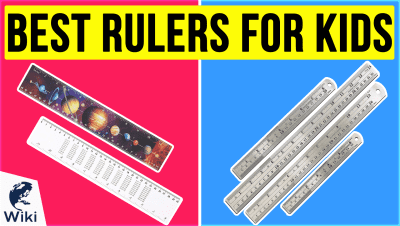The 10 Best Address Books

This wiki has been updated 34 times since it was first published in October of 2016. Not everyone wants to turn on a computer or type using their thumbs each time they need to find someone's information. If you're one of those people who prefers to keep a paper record of all your contacts, check out the address books on this list. We've included small, portable options along with larger, desk-sized ones, in a wide variety of styles to suit all tastes. When users buy our independently chosen editorial recommendations, we may earn commissions to help fund the Wiki.
Editor's Notes
May 18, 2021:
In this update, we replaced the At-A-Glance Undated with the At-A-Glance Large Print, which has many of the same features as the Undated, but is designed to be easy to read, which is helpful for those with visual impairments.
The Peter Pauper Little Black Book was removed because its pages had a tendency to stick together and tear easily. The Iconikal Spiral-Bound was removed because it felt a bit flimsy and the pages were so thin that ink bleeding through was a common issue. The Gallery Leather Acadia was removed because its binder-style rings often didn't close properly, causing damage to the pages. It also had dedicated lines for both fax and pager, which isn't especially helpful in this day and age. Overall, it simply didn't seem worth its higher-than-average price tag.
In adding new items to the list, we wanted to focus on variety to make sure that we covered as many different features and styles as possible.
The Hallmark Refillable is a great option for those who are worried about running out of space, as refill pages are available and easy to fit in under any section. It also has a good amount of extra information on hand for easy reference, including a time zone map, a list of different flowers and their meanings, and a space for frequently called numbers, utilities, and services.
As the name implies, the Re-Focus Left-Handed is designed especially for lefties. Its main purpose is to store passwords, but it does have room for contacts as well, so if you're looking to keep all of that info in one place, this can be a good option. The "backwards" spiral binding can make it easier for left-handed people to write in, but it can also take some getting used to, so expect a bit of a learning curve.
If you want to pass the tradition of keeping an address book down to your little ones, the Slice of Life Kids is a good choice. It has a dotted mid-line that makes it easier to use for young children who are just learning to write. In addition to penmanship, it can also teach kids about putting things in alphabetical order and the basics of organization.
February 28, 2020:
Even though we like the bold cover found on the Peter Pauper Making Connections, there are occasional issues with missing pages, so we've decided to remove it at this time. But there are still plenty of other great options from this popular maker, including the handsome Peter Pauper Celestial and the Peter Pauper Fuchsia Blooms. They're colorful, usable, and fun, although the latter is on the smaller side. That's also true of the Peter Pauper Little Black Book and the At-A-Glance Undated; if you have large, sloppy handwriting, you might find them a bit frustrating to use. On the other hand, they'll probably fit in your purse or briefcase easily, so they're good for those who are always on the go.
At the other end of the size spectrum is the Moleskine Pro, a top choice for its quality as well as its simple styling that will match a range of day planners. The Gallery Leather Acadia is amply sized, as well. Finally, we've opted to add the Iconikal Spiral-Bound as a budget-friendly option. It doesn't have fancy lettering, thick pages, or an elaborately decorated cover, but it won't break the bank and is fine for casual use.
Special Honors
The Comano by Maxwell-Scott The Comano by Maxwell-Scott is made in Italy with handcrafted leather, and was created to be every bit as durable as it is eye-catching. The classic, understated style will fit right into any office environment, whether you choose a tan, black, or dark brown version. us.maxwellscottbags.com
PurpleTrail Customizable When plain, off-the-shelf items just won't do, you'll want to consider the PurpleTrail Customizable. You'll find a wide range of cover designs to select from, many of which allow you to add your own photos along with your name or initials. purpletrail.com
A Brief History of Addresses
Numbering buildings is now integral to everything from mail delivery to taking the census, yet it's not practiced worldwide.
Addresses are one of those things we take for granted. However, for most of human history, directions were given in relation to landmarks, so if you wanted to tell people how to get to your house, you had to tell them to turn right at the big rock — no, not that one, the other one.
That all changed in the 18th century C.E. The Enlightenment was in full swing, and it brought with it a desire to classify almost everything under the sun. Scientific taxonomy took off during this time, and it wasn't long before scholars turned their gazes towards numbering buildings.
There were other reasons driving the need to number buildings: namely, the desire to conscript citizens into the army, and also the need to tax those same citizens to pay for the wars they were being forced to fight. This was easier to do back when people lived in small, spread-out villages, but as the Industrial Revolution drove people to live in densely-packed cities, it became harder to keep track of who lived where.
The Prussian empire was especially big on house numbering. The practice was extremely unpopular, as the numbering often portended danger — such as a draft. Citizens would try to remove the numbers as soon as they were posted, and riots even occasionally broke out in an attempt to stop them from going up.
There were other sinister reasons to label houses. In Prague, Jewish homes were the only ones marked, which allowed the residents to be tracked and contained — a precursor to the number tattoos that the Nazis would later use.
The United States would make much more civilized contributions to the cause, as the concept of putting odd numbers on one side of the street and even on the other originated in Philadelphia in the late 1800s. The Philadelphians didn't quite master it, however, as they started at one end of the street, counted all the way up, and then continued the count on the way down the other side, so you had wildly mismatched numbers facing each other.
Numbering buildings is now integral to everything from mail delivery to taking the census, yet it's not practiced worldwide. Japan is the most notable holdout, which can cause massive confusion to tourists. Chances are, though, that whatever city you're in will have some sort of numbering system.
Which is good for us, because we're really trying to start our own army.
Why You Still Need an Address Book
In this day and age, having a old-fashioned paper address book may seem outdated. After all, don't you have that information stored on your cell phone and or online?
While that's certainly true, there are still reasons to keep an address book handy.
The biggest reason is because — as we've all been made painfully aware from time to time — technology can fail.
The biggest reason is because — as we've all been made painfully aware from time to time — technology can fail. Your phone can break, your email can get hacked, and your computer can go on the fritz. We're not claiming that paper address books are immune to disasters, as they can just as easily be lost or stolen, but it helps to have a backup of all your important contacts. After all, how many phone numbers do you know by heart?
Having a physical book that you always keep in the same place can be vital in case of emergency as well. Finding your cell phone can be difficult if you're frazzled, and your computer will be useless if the power goes out. Having that paper book — and, of course, a landline — could be incredibly helpful in a pinch.
Beyond that, paper address books just have more character than their electronic counterparts. Being able to fill it up and update it gives you a concrete record of all the changes you and your friends have made over the years, and it's a great way to track marriages and births, or even to commemorate those who have passed.
While having a physical book is far from a necessity, it is a good idea. Plus, they're relatively cheap, so it's not like you'd be breaking the bank in order to safeguard your information.
Oh, and it's incredibly satisfying to cross out people's names when they make you mad. That's worth the price of admission right there.
Tips for Using Your Address Book
Using an address book seems incredibly simple. All you have to do is write people's names and contact information down, right? How hard can that be?
If you've ever actually used one, though, then you already know how easy it is to turn yours into a jumbled mess. However, with a little planning, you can make sure that yours remains a pristine and useful tool.
One big trick is to organize everyone by first name instead of last.
One big trick is to organize everyone by first name instead of last. That's especially useful for the women in your life, as their last names can change as they get married or divorced, but it works just as well for the men. It will be much easier to find their information later if you forget their last name.
Write names down with a pencil rather than pen as well. People move and change phone numbers all the time, and scribbling out old information will quickly cause your book to become messy and unreadable.
If you insist on using a pen, though, use multiple colors. This lets you color-code pertinent information, so you can quickly find the number for your child's pediatrician, and your aunt's number will stand out on a page filled with old co-workers and forgotten neighbors.
You don't have to just store contact information in your book, either. You can also keep track of favorite websites, as well as user names and passwords. That way, you'll never be locked out of your other address book — but if you are, you'll have your kid's cellphone number written down, so you can call them and ask how to get back into your email.




